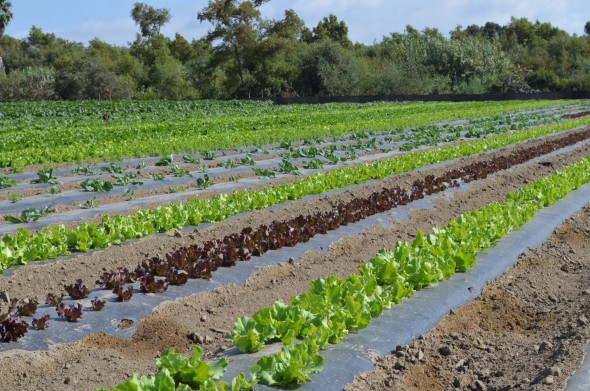Civil Eats | Aug. 11, 2015
Most leafy green lovers probably remember the moment when they became suspicious of spinach.
In 2006, an E. coli outbreak that killed three people and sickened about 200 more was traced to the cool-weather crop growing along California’s Central Coast. Despite the fact that federal and state investigators claimed it was not possible to determine exactly how the dangerous E. coli strain spread to the farm, cattle and wild pig manure were implicated as the sources of the bacteria.
The following year, the state’s farming industry pushed out the California Leafy Greens Marketing Agreement, a set of recommended practices based on previous guidelines issued by to U.S. Food and Drug Administration (FDA) to promote food safety on farms. Though voluntary, it covers over a dozen salad fixings (think spinach, arugula, kale, and several types of lettuce) and has since become widespread throughout the nation.
Simultaneously, many produce buyers began asking growers to clear areas near fields of any vegetation. As a result, the farm fields along the California coast changed radically after the outbreak, as farmers did away with wooded areas, medians, and hedgerows, and most farms became relatively sterile landscapes, aside from the crops.
Now a new study [PDF] is calling the efficacy of that practice into question.
“The bottom line is that removing habitat around farm fields is ineffective at making food safer from pathogens,” said Daniel Karp, a U.C. Berkeley postdoctoral researcher whose work is funded by The Nature Conservancy. “It has been shown in this region that there are a lot of benefits to surrounding vegetation as well, such as providing a home for pollinators, which are declining across the nation.”
The research—which was published yesterday in the journal Proceedings of the National Academy of Sciences (PNAS)—used three sets of industry data from 2007 to 2013 and mapped the results of 236,000 tests for E. coli and Salmonella on leafy greens, irrigation water, and rodents on Central Coast farms.
Karp and his collaborators found that among 57 farms in Salinas, Monterey, San Benito, Santa Clara, and Santa Cruz counties—the source of three-quarters of the the country’s leafy greens—the overall frequency of disease-causing strains of E. coli increased in the six-year period. But it turned out the prevalence increased the most where surrounding wildlife vegetation had been cleared away.
In areas that had kept some natural vegetation intact—a fact the researchers verified using aerial imagery—the team also found that the overall presence of disease-causing strains of E. coli and Salmonella did not go up.
Karp says that by looking to California as an example, the study results could have implications for all of America’s 4.5 million acres of farmland where foods eaten raw are grown, and the wildlife habitat that surrounds this land.
“Federal legislation [enacted] in 2011 will give the FDA the ability to regulate farming practices,” he said, referring to the controversial Food Safety Modernization Act that has yet to be implemented. “While it doesn’t require farmers to remove habitat, my worry is that these practices will spread across the nation as buyers will put pressure on their growers and won’t buy from them unless they remove wildlife habitat.”
The Wild Farm Alliance, a nonprofit organization that advocates for the importance of protecting native species through sustainable agriculture has expressed concern about the dangers of removing wildlife habitat near leafy green crops all along.
Karp points to ways that conservation, agriculture, and livestock can flourish side by side, such as maintaining natural habitat (like trees) as a buffer between livestock and leafy green fields. The vegetation could filter runoff from grazed lands in the soil, he said.
“Or you could plant crops that need to be cooked, like artichokes, corn or wheat,” as buffer between livestock and leafy greens, Karp said.
Another option that could possibly work, he said, is to fence off waterways upstream from leafy green fields in order to prevent wildlife and cattle from defecating in the stream, which might eventually transport the feces downstream.
“We need to talk about how we can manage farming systems that both produce food and livestock and conserve nature at the same time,” Karp said. “We need to think creatively.”
Figure from study: Promising practices include (1) planting low-risk crops between leafy green vegetables and pathogen sources (e.g., grazeable lands); (2) buffering farm fields with noncrop vegetation to filter pathogens from runoff; (3) fencing upstream waterways from cattle and wildlife; (4) attracting livestock away from upstream waterways with water troughs, food supplements, and feed; (5) vaccinating cattle against foodborne pathogens; (6) creating secondary treatment wetlands near feedlots and high-intensity grazing operations; (7) reducing agrichemical applications to bolster bacteria that depredate and compete with E. coli; (8) exposing compost heaps to high temperatures through regular turning to enhance soil fertility without compromising food safety; and (9) maintaining diverse wildlife communities with fewer competent disease hosts.

